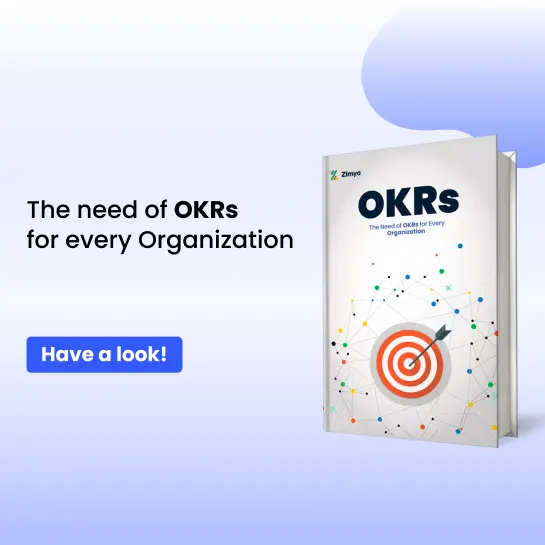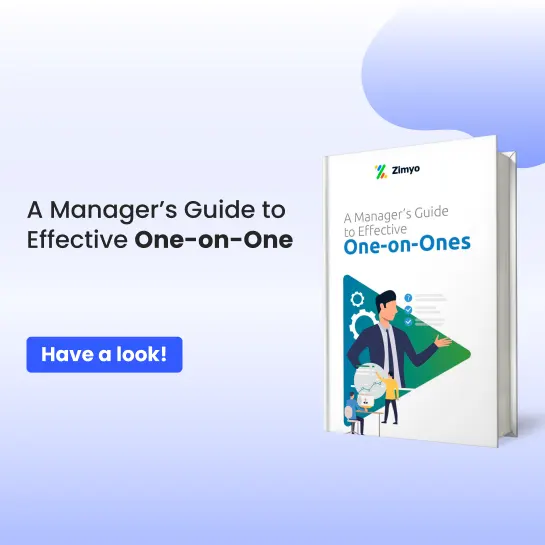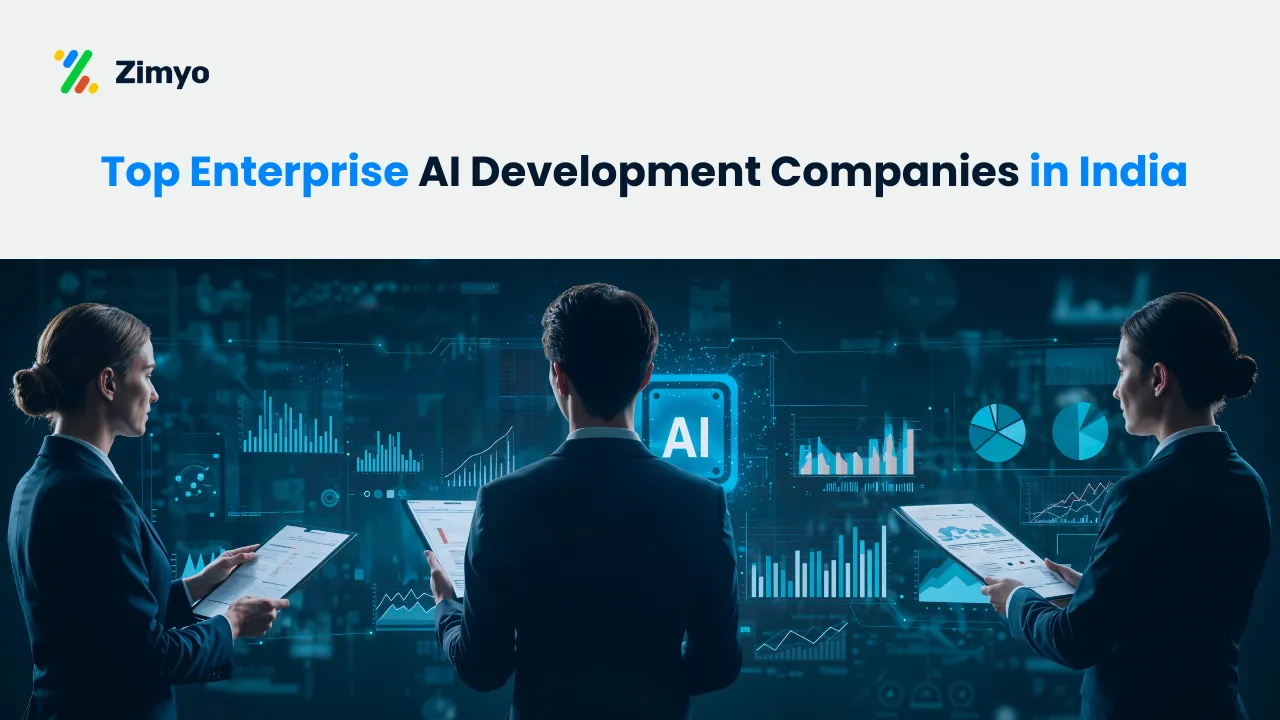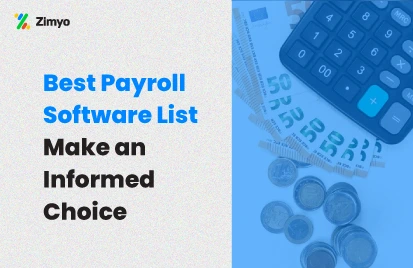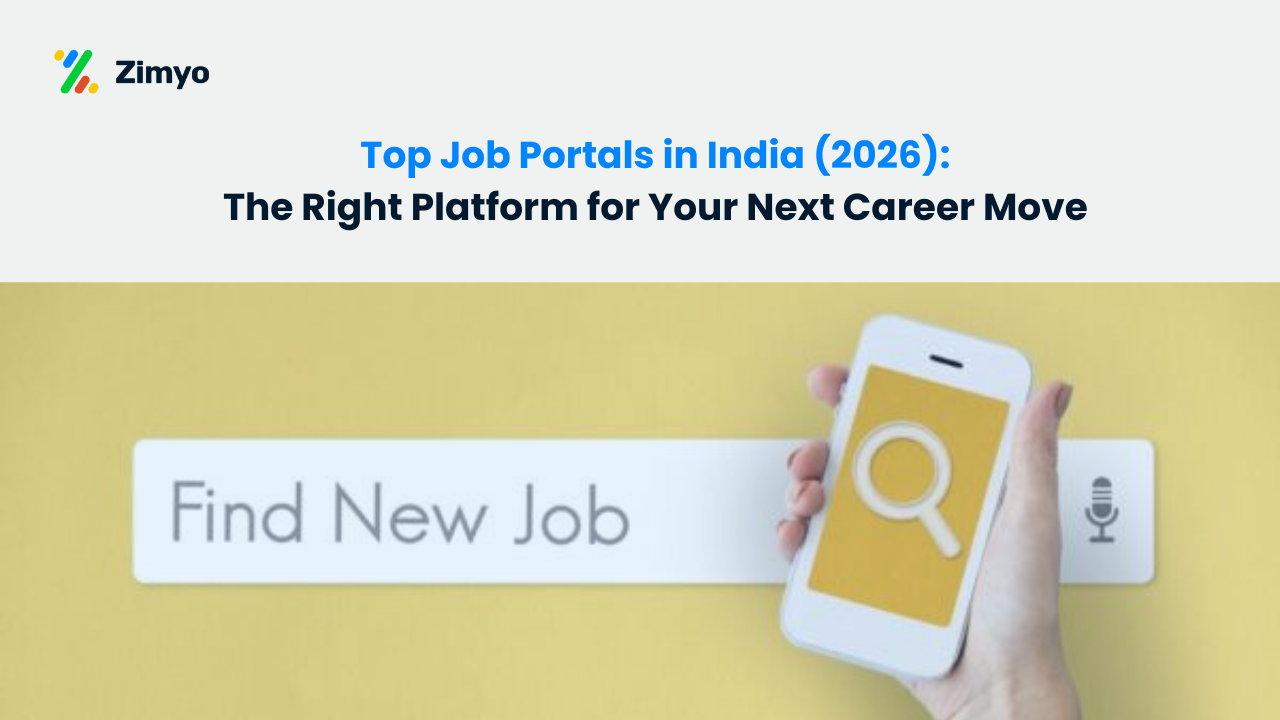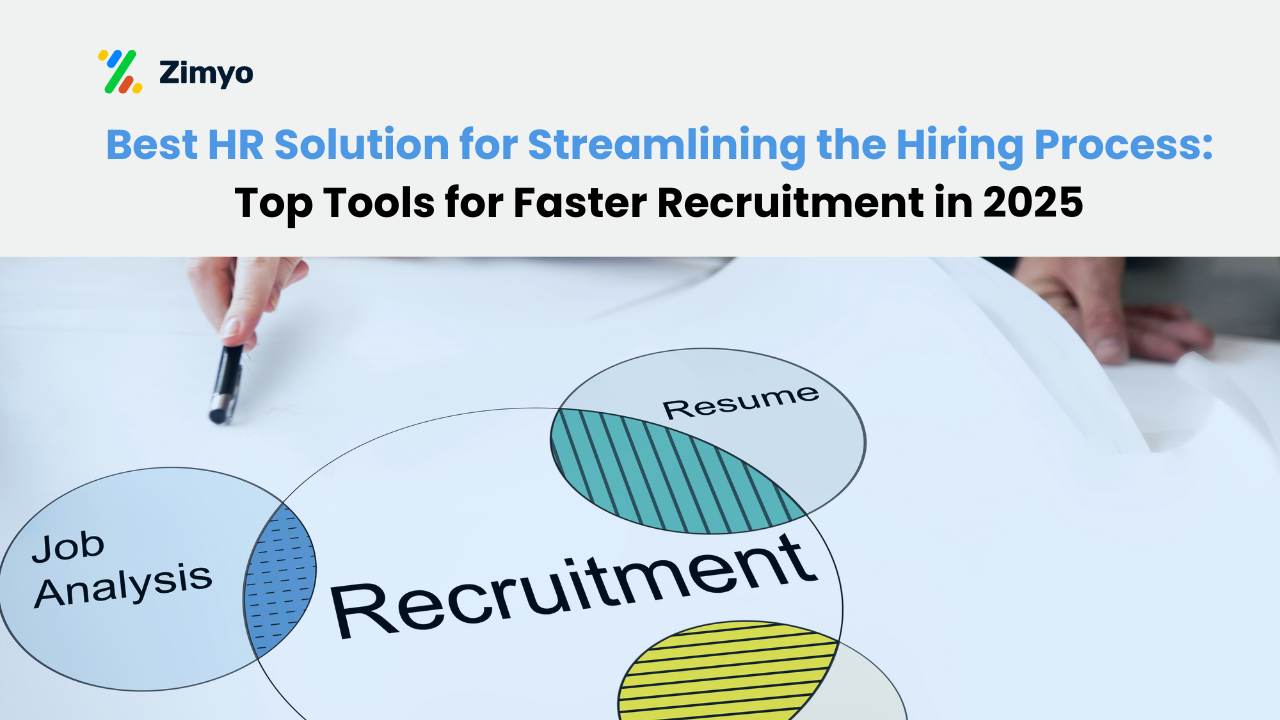Managing people at work can be complicated. From payroll and attendance to performance and hiring, HR tasks take a lot of time and effort. This is why many companies use HRIS (Human Resource Information System) software. A good HRIS helps automate HR tasks, reduce mistakes, save time, and give useful insights to make better decisions.
With so many HRIS options available, choosing the right one can feel confusing. Some software focuses mainly on payroll, some on employee engagement, and some offer everything in one system. Picking the wrong software can waste money, take more time, and frustrate your team.
In this guide, we list the 11 Top HRIS Software ranked by effectiveness. For each software, we explain its history, unique features, pros and cons, and which types of companies it works best for. We also share a simple step-by-step guide to help you pick the right HRIS for your business.
Whether you are a small business wanting basic HR tools or a large company looking for a full cloud HR solution, this guide will help you choose a system that saves time, keeps your HR tasks organized, and makes employees happy.
List of the 11 Top HRIS Software – Ranked by Effectiveness
Here is the List of the 11 Top HRIS Software, ranked by their effectiveness:
- Zimyo
- Workday
- ADP Workforce Now
- BambooHR
- Paycor
- Zenefits
- Gusto
- Rippling
- UKG Pro (Ultimate Kronos Group)
- Namely
- Oracle HCM Cloud
Now, let us throw light on each one of these in precise details and explanation.
Top HRIS Software: A Detailed Guide
1. Zimyo
Zimyo began as an HR tech startup and has grown into a full Cloud Based HRIS Software platform. While its roots are outside the U.S., it now serves clients globally, including in the USA. Zimyo is becoming popular as one of the Modern HRIS Software Tools because it offers many HR functions in one place: attendance, payroll, recruitment, performance, learning, and more. It positions itself as a top option for companies wanting a unified solution rather than many separate software pieces.
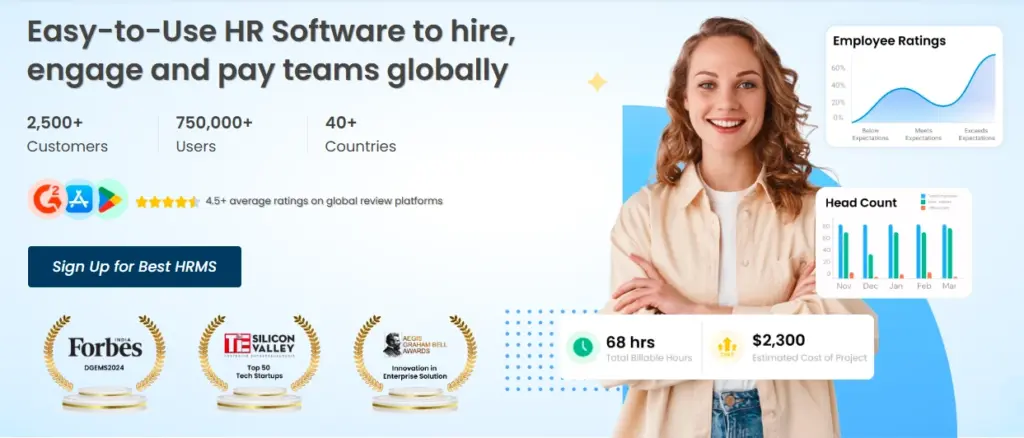
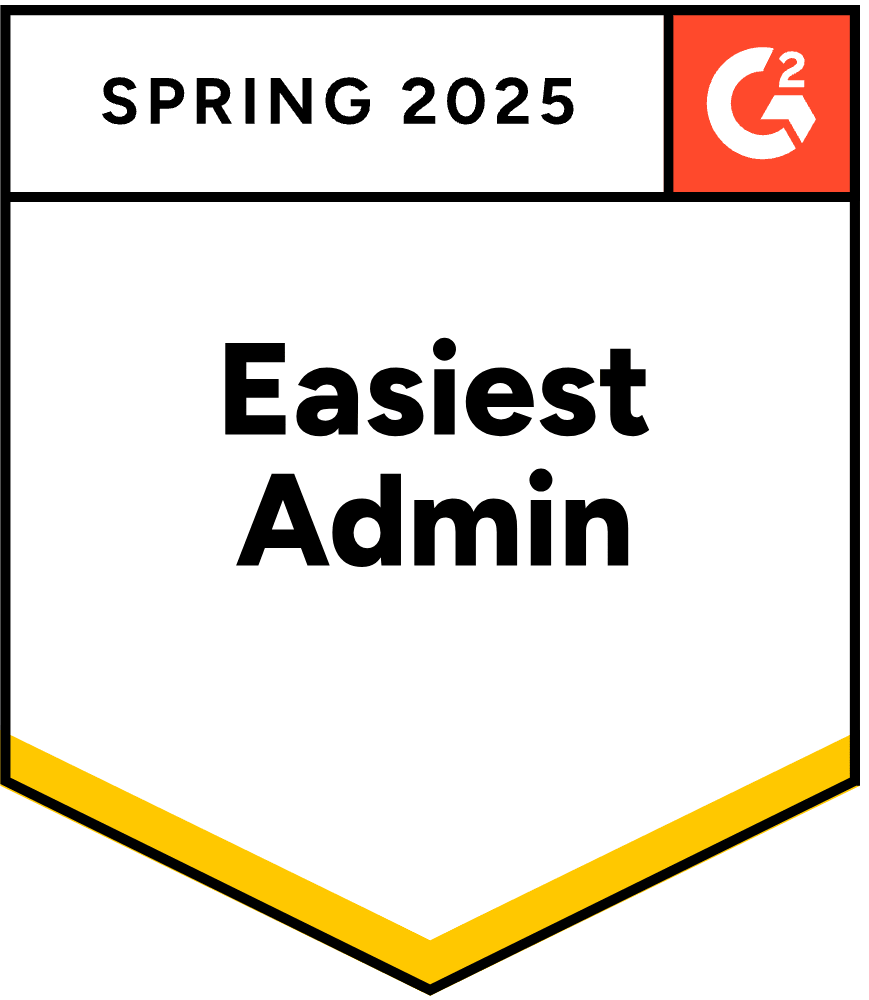
Uniquely Different Features
- All-in-one HR suite: HRIS, payroll, attendance, performance, recruitment, and learning in one product.
- Biometric / facial recognition / GPS / geo-fencing based attendance, with offline clocking.
- Highly configurable workflows for leave, approvals, remote work, shift changes.
- Analytics dashboards that combine data across modules (payroll + attendance + performance).
- Mobile-first design: employees and managers can use mobile app for HR tasks anywhere.
Pros and Cons
Pros | Cons |
Unified HRIS + HRMS software in one platform | Still newer compared to established U.S. players |
Flexible configurations and many modules | Advanced modules may add to cost |
Strong mobile and attendance features | Less brand recognition in U.S. market |
Good payroll integration with HR features | Some integrations may need custom work |
With Zimyo, organizations get a Cloud HRIS Solution that handles HR, payroll, attendance, and performance in a single system. It’s ideal for companies that want to avoid stitching together multiple tools and prefer a Best Cloud HRIS System USA style product… scalable, modern, and integrated.
2. Rippling
Rippling launched in 2016 as a modern platform that unifies HR, payroll, and IT. It quickly grew by offering a single system to manage employee records, payroll, benefits, devices, and apps. Many companies pick Rippling when they want a single tool that automates HR and IT work together. It is seen as a leader among Top HRIS Software and Cloud Based HR Tools.
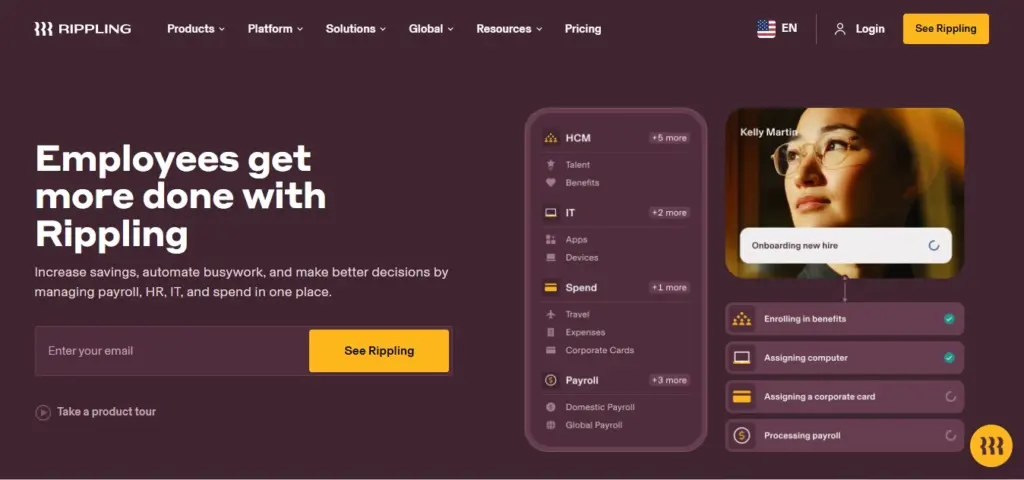
Uniquely Different Features
- Unified HR + IT: automatically provision devices and software when employees are hired.
- Very fast onboarding automation across payroll and apps.
- Global payroll in a single product with integrations that remove manual steps.
Pros and Cons
Pros | Cons |
Strong integration of HR and IT (unique) | Can be expensive as you add modules |
Fast, modern UI for administrators and employees | Some advanced HR reports need setup |
Good for scaling startups and remote teams | Pricing model can be complex |
3. Gusto
Gusto started as a payroll-first company (founded 2011) and expanded into HR tools for small and growing firms. It is known as one of the Best Payroll Software USA picks for small businesses because it makes taxes, benefits, and payroll simple. Gusto targets companies that want easy payroll, benefits management, and basic HR together.
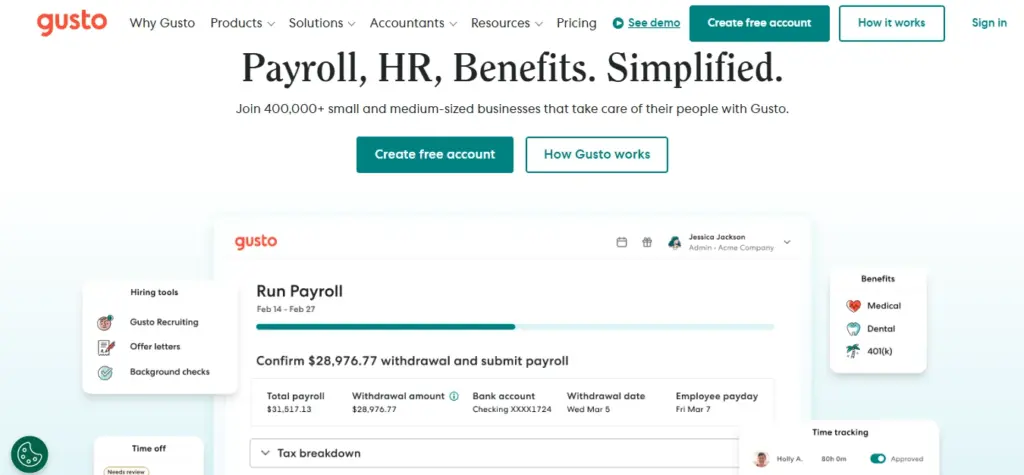
Uniquely Different Features
- Payroll-first UX: automatic federal and state tax filing built into payroll.
- Simple benefits administration for small businesses (health, retirement).
- Easy employee onboarding and document management for small teams.
Pros and Cons
Pros | Cons |
Very easy payroll + tax filing | Not best for very large enterprises |
Ideal for startups and small businesses | Advanced HR workflows limited |
Clear pricing tiers for small teams | Limited global payroll support |
4. Workday
Workday launched in 2005 and became a major enterprise HRIS, combining HR and finance in one cloud platform. It is widely used by large companies that need deep reporting, workforce planning, and global HR features. Workday is a top choice among Best HRIS Software for Enterprises and Cloud Based HRMS Software.
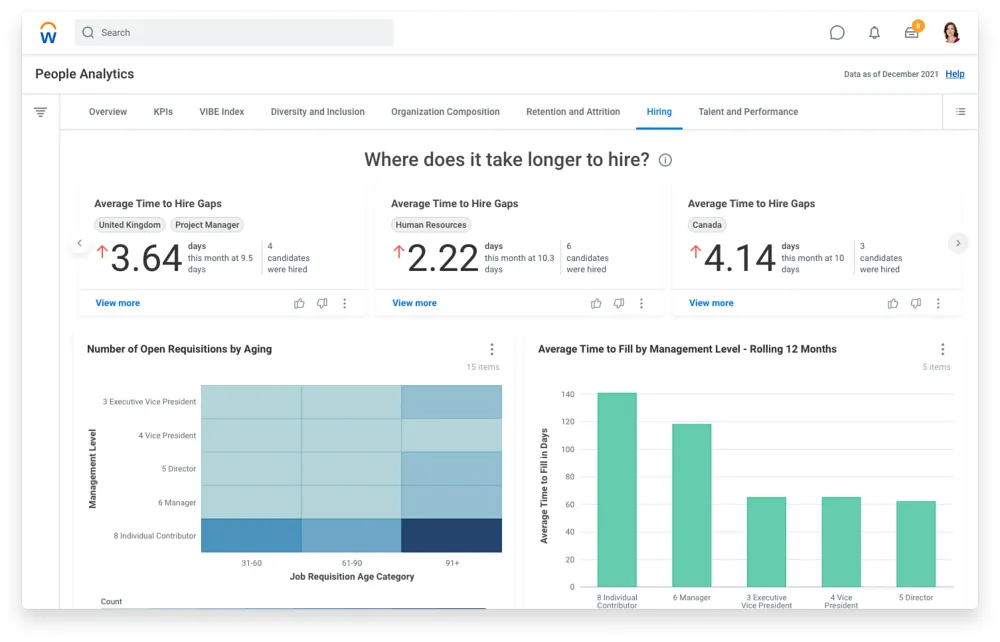
Uniquely Different Features
- Strong HR + Finance convergence for enterprise planning.
- Deep analytics and workforce planning capabilities.
- Highly configurable security and compliance for global operations.
Pros and Cons
Pros | Cons |
Built for global enterprise scale | High cost and long implementation |
Powerful analytics and planning | Complex to learn for small teams |
Rich security and compliance tools | Heavy IT involvement often needed |
5. BambooHR
BambooHR started in 2008 focusing on easy HR for small and mid-size companies. It is known for a clean user experience and strong employee self-service. BambooHR is popular as HRIS Systems for Small Business and a friendly Online HR Software USA option.
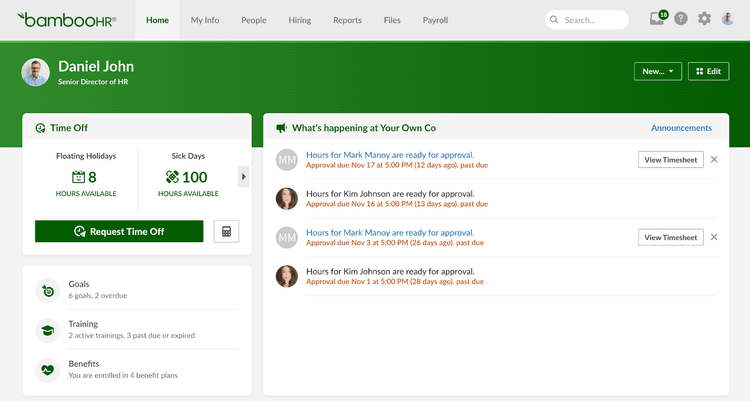
Uniquely Different Features
- Simple, modern UI focused on people and employee experience.
- Clean onboarding and offboarding workflows with task checklists.
- Lightweight performance review tools and employee records.
Pros and Cons
Pros | Cons |
Very easy to use for HR teams and employees | Payroll and advanced features limited in some regions |
Great employee self-service | Not built for very large enterprise complexity |
Fast setup for small businesses | Reporting is basic compared to enterprise systems |
6. Paycor
Paycor has been in HR/payroll business for decades and focuses on mid-market companies. It offers solid payroll, recruiting, and HR management tools. Paycor is commonly chosen as Best HR Management Software USA for teams that need combined payroll + HR tools with good compliance.
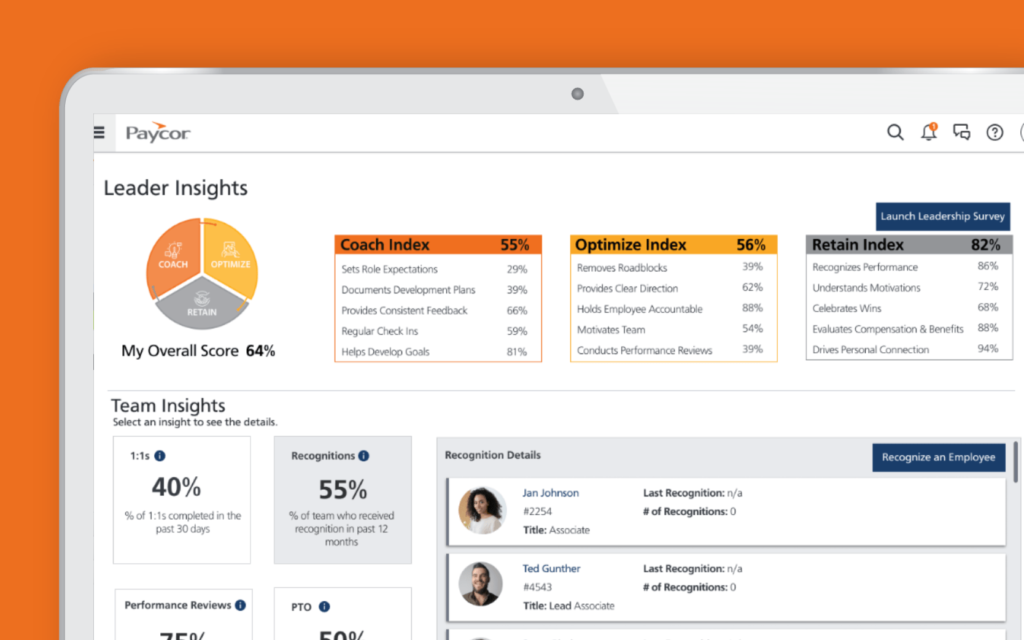
Uniquely Different Features
- Built-in leader dashboards for people analytics and HR KPIs.
- Strong recruiting and onboarding tied closely to payroll.
- Workforce management features for mid-sized firms.
Pros and Cons
Pros | Cons |
Good HR analytics for mid-market | Interface can feel dated to some users |
Payroll + recruiting integrated | Some advanced features cost extra |
Strong compliance and tax support | Support quality varies by account plan |
7. HiBob (Bob)
HiBob (often called “Bob”) started as a modern HR platform focused on culture, growth, and people operations. It targets fast-growing companies that care about employee experience. HiBob ranks among Top HRIS Solutions for Startups and HRIS Software for Remote Work.
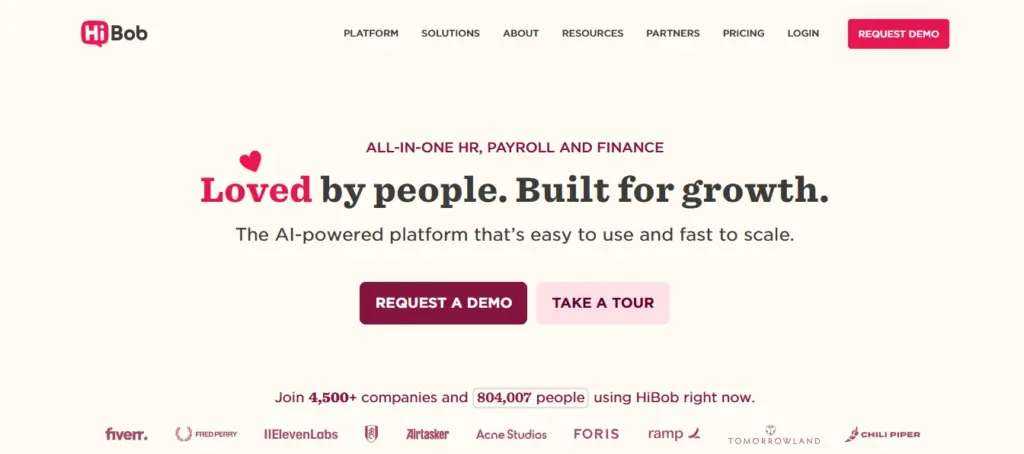
Uniquely Different Features
- Culture and engagement focus built into HR workflows.
- Modern, social-style employee profiles and people analytics.
- Fast implementation and flexible custom fields.
Pros and Cons
Pros | Cons |
Excellent UX focused on engagement | Not as deep in payroll features |
Flexible and modern for remote teams | Smaller integration ecosystem than giants |
Fast time-to-value for startups | Advanced enterprise reporting limited |
8. Zoho People
Zoho People is part of the larger Zoho suite. It provides HR features for small and mid-size companies that want affordable Cloud Based HR Software and integrations with other business apps. Zoho People is often chosen as Affordable HRIS Systems USA.
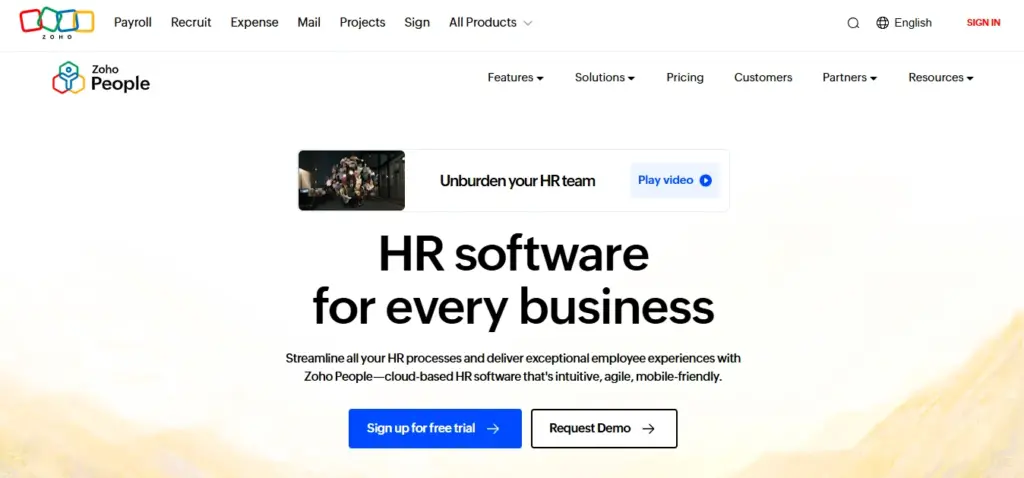
Uniquely Different Features
- Tight integration with Zoho ecosystem (CRM, finance, apps).
- Very affordable entry pricing and modular add-ons.
- Good time tracking and attendance features for small teams.
Pros and Cons
Pros | Cons |
Affordable and modular | Payroll support in some countries limited |
Works well with other Zoho apps | UX not as modern as some rivals |
Good value for small & growing companies | Advanced HR workflows need configuration |
9. Deel
Deel is a newer HR/payroll platform focused on hiring, paying, and managing global contractors and employees. It is widely used by companies that hire internationally and need compliant payroll and contractor management. Deel is a strong pick for HRIS Software for Growing Companies with international teams.
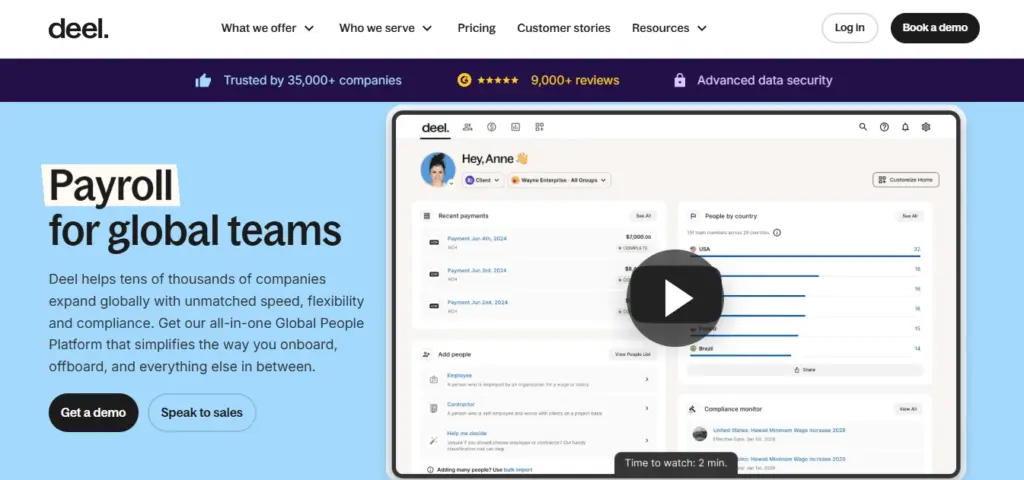
Uniquely Different Features
- Built-in global contractor agreements and tax compliance.
- Multi-country payroll and localized contractor payments.
- Fast setup for hiring across borders.
Pros and Cons
Pros | Cons |
Excellent for global contractor payroll | Can be costly for many full-time employees |
Strong compliance for multi-country hiring | Not a full-featured HRMS for deep HR ops |
Quick setup for international teams | Some features are add-ons |
10. ADP Workforce Now
ADP is one of the oldest payroll and HR companies. ADP Workforce Now is its cloud HR platform for mid-size to large U.S. companies. ADP is known for payroll strength and compliance, and it sits among Top HR Companies in USA and Payroll Management Software USA.
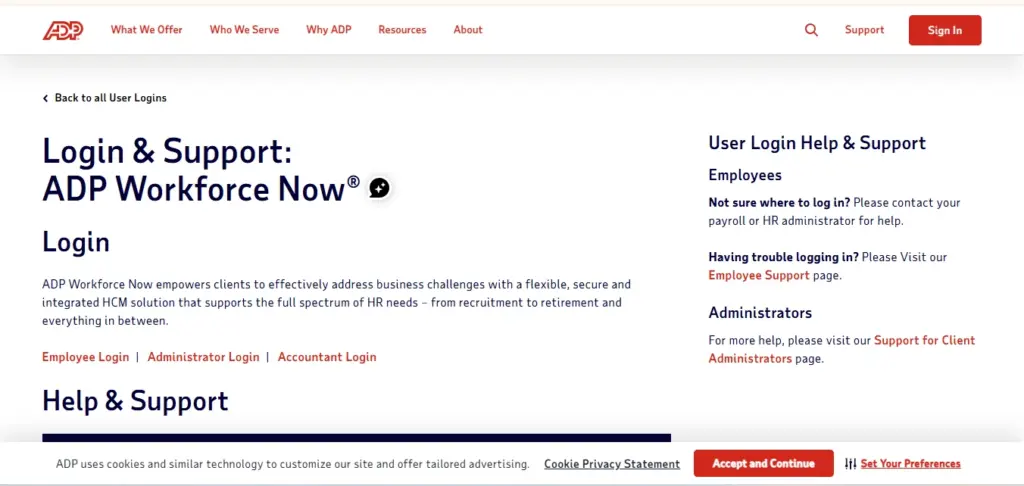
Uniquely Different Features
- Deep payroll and tax compliance with wide state coverage.
- Large partner ecosystem and integrations.
- Robust reporting and long-standing HR features for regulated industries.
Pros and Cons
Pros | Cons |
Very strong payroll and tax support | Can feel complex and costly for smaller firms |
Trusted brand with long history | User interface can be clunky |
Works for regulated and large employers | Implementation and change can take time |
11. Paylocity
Paylocity started as payroll software and evolved into a cloud HR platform for mid-market companies. It offers payroll, HR, time, and talent features, and is viewed as a reliable HRIS and HRMS Software USA option for companies that need a balanced set of HR tools.
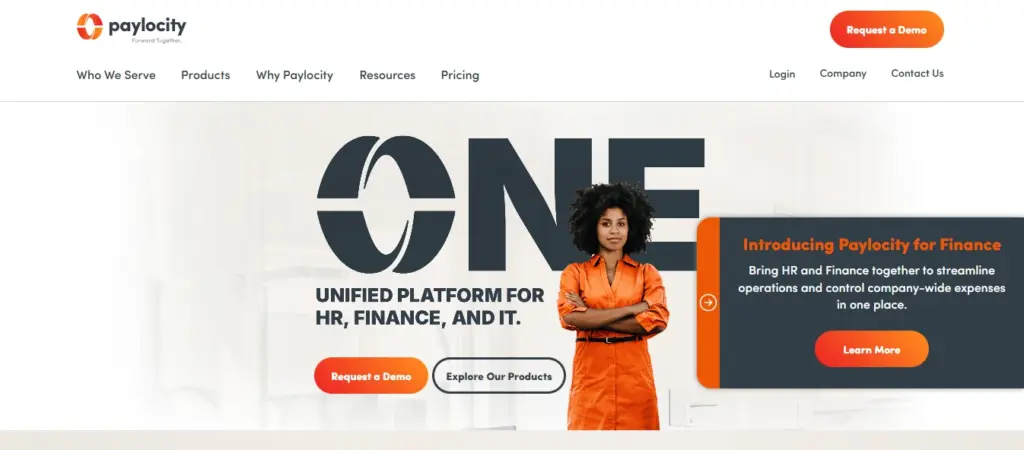
Uniquely Different Features
- Strong focus on employee communication and mobile experience.
- Built-in learning and engagement tools with payroll.
- Flexible time and attendance modules.
Pros and Cons
Pros | Cons |
Good blend of payroll + HR features | May need consultants for complex setups |
Strong mobile and communication tools | Advanced analytics less deep than large enterprise tools |
Good for growing mid-market companies | Pricing varies with add-ons |
Simple Guide: How to Choose the Top HRIS Software
Picking the right HRIS (Human Resource Information System) is a big deal for any company. The right choice saves time, cuts mistakes, keeps you legal, and makes employees happy. The wrong choice wastes money and causes stress.
Here’s a simple step-by-step guide to help you make the best decision.
Step 1: Get ready and form a team
- Decide why you need HRIS (payroll, attendance, onboarding, compliance, reports, etc.).
- Form a small team: HR, finance, IT, and one or two employees who will use it.
- Write down your goals in one page.
Output: clear goals + list of people in charge.
Step 2: Look at your current system
- Map how you do things today: payroll, leave, hiring, training, etc.
- Note problems like late payroll, missed records, or slow onboarding.
- Write down how much time is spent each week.
Output: list of pain points and what you want to improve.
Step 3: Make a must-have vs nice-to-have list
- Must-haves: payroll integration, compliance, mobile access, reporting, security.
- Nice-to-haves: advanced analytics, learning tools, global payroll, extras.
Output: a requirements list.
Step 4: Fix your budget
- Check costs: license per employee/month, setup, integration, training, support.
- Plan for at least 3 years to see the total cost.
Output: 3-year budget plan.
Step 5: Shortlist vendors
- Start with 8–10 vendors, then cut down to 3–6 that fit your needs and budget.
- Ask for references in your industry.
Output: a final list of vendors to check deeply.
Step 6: Prepare demo questions
Don’t let vendors show random slides. Ask them to show your processes.
Examples:
- Run payroll for 200 employees.
- Add a new hire and onboard them.
- Request and approve leave.
- Show mobile self-service.
- Show integration with your current payroll/finance system.
Output: a script to test each vendor fairly.
Step 7: Run demos and score them
- Use a scorecard: rate 1–5 for things like payroll, ease of use, reporting, cost, support.
- Compare all vendors with the same scale.
Output: clear scores, less bias.
Step 8: Check references and test with real data
- Talk to real customers about support, hidden costs, and time to go live.
- If possible, run a pilot with 50–200 employees to test payroll and reports.
Output: proof the system works in real life.
Step 9: Negotiate the deal
- Ask for clear prices for 3 years, with caps on increases.
- Make sure you own your data and can export it anytime.
- Get uptime guarantees (SLA), support response times, and training included.
Output: a safe contract.
Step 10: Plan rollout and training
- Create a timeline: setup, test, train, go-live.
- Train HR, managers, and employees with simple guides.
- Roll out in phases (small pilot → full company).
Output: a smooth rollout without chaos.
How to measure success after launch?
- Time to run payroll (should be faster).
- Errors in payroll (should drop).
- Hours saved in HR admin.
- Employee usage of self-service.
- Time to onboard new hire.
- How fast reports can be generated.
Tips & Pitfalls
- Do check references.
- Keep it simple, don’t over-customize.
- Train people well.
- Don’t choose based only on a pretty demo.
- Don’t forget hidden costs like training and support.
Final check before signing
- Must-haves all covered?
- Budget fits 3 years?
- Pilot works fine?
- References are positive?
- Is contract safe and clear?
If yes → Go ahead and sign.
Conclusion
Choosing the right HRIS software can make a big difference for your company. The right system saves time, reduces mistakes, keeps payroll and compliance in check, and helps employees work better. By understanding each platform’s features, pros and cons, and matching them to your company’s needs, you can make a smart choice.
Remember to plan carefully, test the software with real data, check references, and train your team well. With the right HRIS, your HR processes become smoother, your employees happier, and your business more efficient.
Frequently Asked Questions (FAQs)
What is HRIS software?
HRIS stands for Human Resource Information System. It is software that helps companies manage HR tasks like payroll, attendance, hiring, performance, and employee records in one place.
Why do companies need HRIS software?
HRIS software saves time, reduces errors, improves compliance, and helps HR teams manage employees more efficiently.
What is the difference between HRIS and HRMS?
HRIS mainly focuses on storing and managing employee information. HRMS (Human Resource Management System) includes HRIS features plus additional tools like payroll, performance management, and recruitment.
How do I choose the right HRIS software?
Consider your company size, budget, must-have features (payroll, compliance, reporting), and employee needs. Test software demos and check references before deciding.
Can small businesses use HRIS software?
Yes. Many HRIS solutions are designed for small and medium businesses, offering easy-to-use features at affordable prices.
Do HRIS systems support global payroll?
Some HRIS systems like Workday, Rippling, and Deel support global payroll. Others may focus only on the U.S. or local regions, so check before choosing.
Is cloud HRIS software better than on-premise?
Cloud HRIS is usually easier to set up, access from anywhere, and maintain. On-premise may offer more control but requires IT support and can be expensive.
How much does HRIS software cost?
Costs vary by vendor, number of employees, and features. Most systems charge per employee per month, plus setup or training fees.
Can HRIS software integrate with other tools?
How do I measure HRIS success?
Track metrics like time saved on HR tasks, payroll errors, employee usage of self-service, speed of onboarding, and quality of reports.

